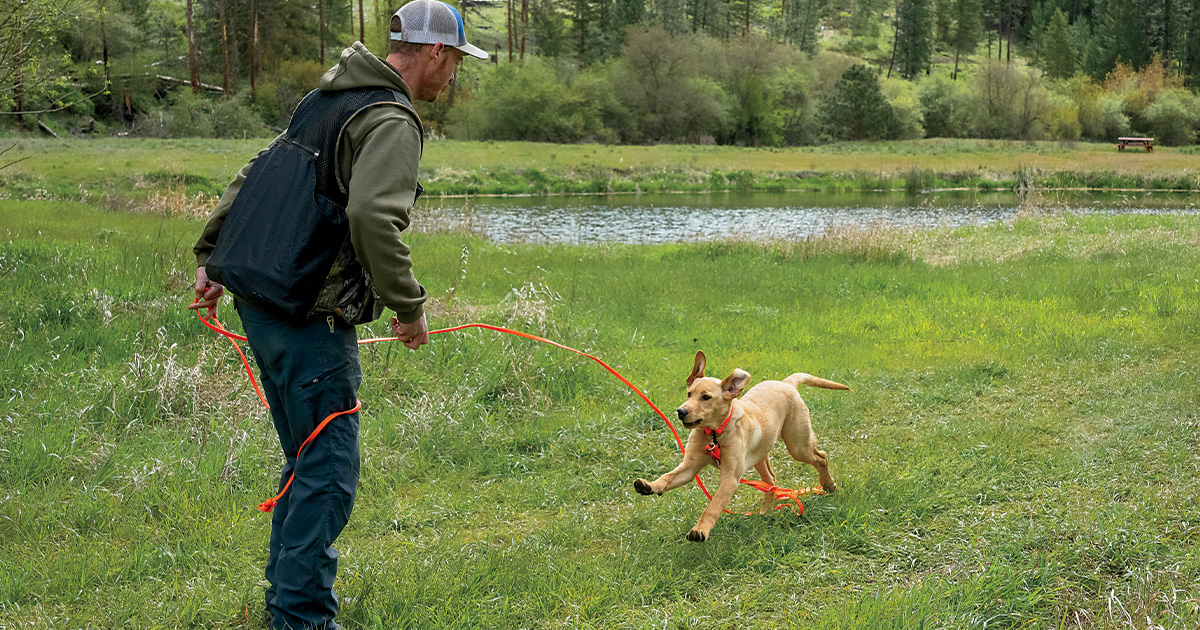Retrievers: Total Recall
Expert advice for teaching a foundational behavior
Expert advice for teaching a foundational behavior


A long check cord is an invaluable tool for teaching recall.
A friend of mine, now well into his 80s, subscribes to a very simple dog training formula: “Get a pup from decent breeding, teach him his name and to come when you call him, take him hunting.” Of course, it’s a little more complicated than that, but it cuts to the essential truth that as long as you have a dog that will come when you call, you’re miles ahead of the game.
One universal principle to keep in mind when teaching this foundational behavior is to always make the act of recalling a pleasant experience for your dog. When he complies, love him up, say good dog or something similar (try to use the same words every time), and reward him with a food treat from time to time. You’re trying to forge that positive association and lay a foundation for the desired behavior, and you want your dog to come to you eagerly, not reluctantly. Never, ever correct your dog for an infraction committed “out there” when he comes in. It accomplishes nothing and sends entirely the wrong message.
The basic process of teaching recall includes three stages. First is the “play” stage, where you encourage your puppy to come to you by getting down on your knees, calling his name, and using whichever verbal command you’ve chosen (most pros prefer here, but come is perfectly acceptable). If you want to clap your hands to get his attention, that’s fine, too. Don’t overdo it, and don’t make it hard on your pup by calling him when he’s obviously distracted (that’ll come later).
When your pup is three to four months old, advance to the second stage by clipping a light 20- to 30-foot check cord to his collar (a standard flat collar, not a chain-type collar). Let your pup wander around a bit while you hold the free end of the cord, then call his name and give him the recall command. If he complies, praise him and let him know what a good dog he is. If he doesn’t, gently but firmly tug on the cord. Don’t reel him in with continuous tension. Instead, use repeated tugs, releasing pressure when he begins moving in the right direction. Again, don’t overdo it. Three or four reps per day is plenty. And remember to always keep these sessions upbeat.
“Tone of voice is so important,” notes Bob Olson, the veteran pro at River Road Kennels in Lena, Wisconsin. “Think about when you were a kid and your mom called you to come inside. You don’t want to use the ‘Get in here right now and clean your room’ voice. You want to use the ‘I just baked a batch of chocolate chip cookies’ voice.”
When your pup is reliably coming in with little or no need for you to tug on the check cord, you can start overlaying a whistle signal on top of the verbal command. Most trainers use three short blasts, which can easily be differentiated from the single blast that means sit.
In the third and final stage, the e-collar (if you use one) comes into play. Once the pup has been collar-conditioned—generally at six or seven months of age—the e-collar gradually replaces the check cord as the pressure-delivery mechanism. There are two schools of thought about the best way to do this. One involves applying a low level of continuous stimulation until the dog comes all the way in. The other uses momentary “nicks”—analogous to those quick tugs on the check cord—to keep the dog on task.
“I’m a ‘nick’ guy,” Olson explains. “Every time the dog dawdles, veers off, or seems to lose focus, I give him a nick to bring him around. I like the fact that the dog instantly associates his behavior with the correction.”
Finally, you can use the e-collar to add a tone overlay (the vibration function also works for this). Give your standard recall command, then add a tone signal from the collar, enforcing compliance as necessary. This way, the tone essentially becomes a command. This is especially useful in windy conditions, when your dog is operating at long range, or when you’re hunting upland game and want to make as little noise as possible.
Ducks Unlimited uses cookies to enhance your browsing experience, optimize site functionality, analyze traffic, and deliver personalized advertising through third parties. By continuing to use this site, you agree to our use of cookies. View Privacy Policy